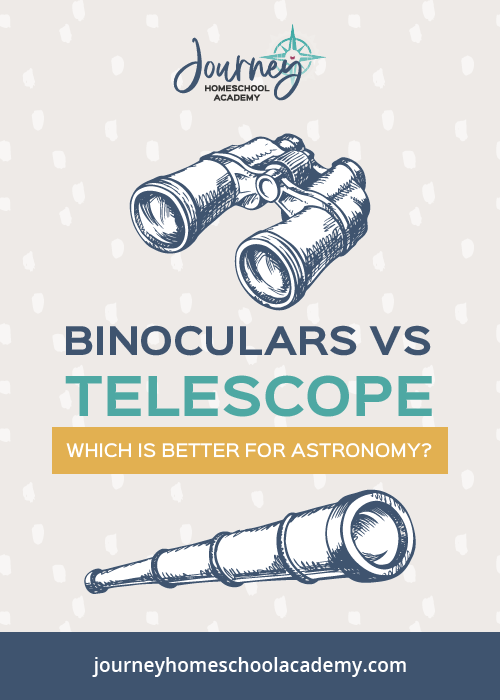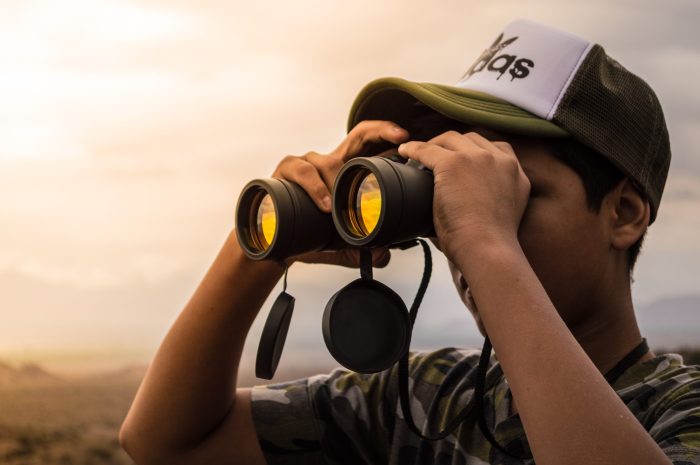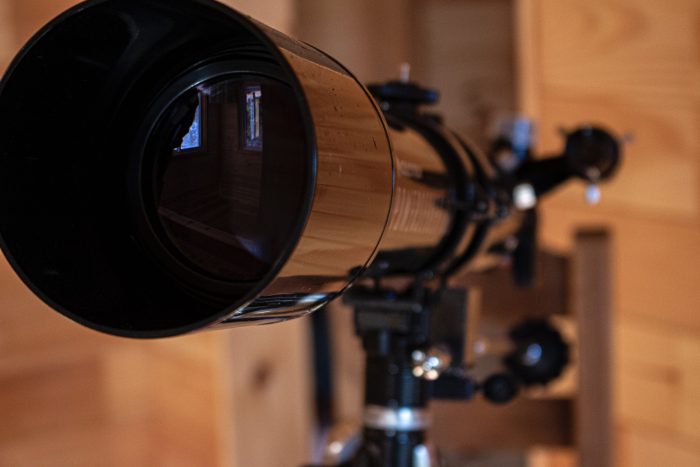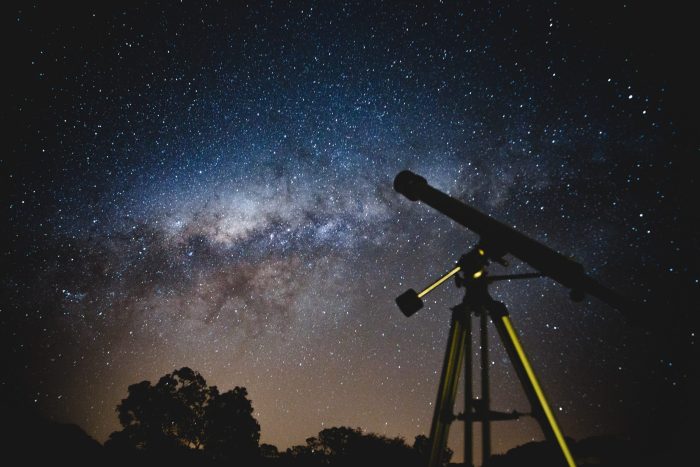Have you ever taken a pair of binoculars and looked directly into the sun? No? Just me? As my mom used to say, “Stop it, you’re going to go BLIND!” (Good news, my vision is still perfect. Sorry, Mom.)
Both binoculars and telescopes are widely known tools used to, put quite simply, look at things that are far away! We pull out our binoculars to look at birds, watch baseball games, and look for deer during hunting season. While telescopes are commonly used to help us get a high-quality view of the night sky from the comfort of our window or backyard.

But when it comes to studying astronomy and selecting what will best suit your homeschool science needs, which do you purchase—binoculars or a telescope? And, with so many options on the market, what do you look for when purchasing?
How Binoculars Work

When you look through a pair of binoculars, you see a clear, magnified image. But what we rarely think about is just how the image we are viewing is magically magnified. Binoculars function thanks to the work of light, lenses, and prisms.
Each mini telescope (one for each eye) on a pair of binoculars has a lens, also known as an objective lens, that collects light from an object. The objective lenses generate an upside-down image when light is collected, then, a prism that sits behind the objective lens flips the image. This creates the magnified view we see when we look through binoculars. So, when you point your binoculars at the moon, you’re going to see exactly what you would see with the naked eye—just much closer!
There are two basic types of binoculars: Porro prism and roof prism. The Porro prism design has a zigzag shape that sends the light through two sets of offset prisms. This creates a wider view but, but it’s a clunkier object to hold. Roof prism binoculars are generally small and compact because the prisms are perfectly aligned, creating a crystal-clear image, though the view is narrower than a Porro prism.
Pros and Cons of Binoculars
When choosing whether to use binoculars for astronomy, consider the following pros and cons:
Pros:
- Affordable
- Easy to use (especially for elementary-age kids!)
- You get to use both of your eyes which creates a better view experience
- Wider and 3D view
- You likely already have a pair!
Cons:
- Unsteady hands will result in a shaky image—buying one to mount on a tripod is a must
- Very difficult to use for highly focused magnification (e.g., the intricate details of a planet)
How Telescopes Work

Similar to binoculars, there are two primary types of telescopes used by consumers: refracting telescopes and reflecting telescopes. These two designs differ in the way that light is collected.
Refracting telescopes collect light through an objective lens to form an image, and then the eyepiece lens magnifies that image for us to see. The technology used in refracting telescopes is quite similar to that used in binoculars. The difference, however, is that the lenses in telescopes are larger than those in binoculars. This produces a higher-quality image, even if the lighting is poor.
Reflecting telescopes are the most commonly used telescopes for astronomy, and the famous Hubble Space Telescope follows this design. The reflecting model uses mirrors instead of prisms. The first mirror collects light from an image and bounces it off to another mirror. This second mirror then bounces the light to the eyepiece lens that magnifies the object.
Mirrors are cheaper to make in large sizes, but they require impeccable cleaning, and even the slightest flaw will ruin the entire image. However, unlike lenses, the mirrors used in reflecting telescopes don’t cause a distortion of color on the edges of the image (also known as chromatic aberration).
Pros and Cons of Telescopes
Now that you know how telescopes work (fascinating, isn’t it?!), consider these pros and cons:
Pros:
- Incredible image quality
- High magnification
- Great performance, even in less than great conditions
Cons:
- Can be expensive
- Takes time to learn and master
A Few More Things to Consider

So many amateur astronomers think that a telescope is an obvious choice over binoculars. While telescopes are an excellent choice for astronomy, binoculars can also be used with greater ease and less cash out of your pocket. Your homeschooler can have an adequate and even exceptional learning experience with a pair of binoculars and a dark sky. But you also won’t be disappointed by the capabilities of a telescope!
If you’re thinking, “Okay, both sound great, so which one do I choose?!” ask yourself these questions:
- Does your science curriculum require the use of these tools?
(At Journey Homeschool Academy, our homeschool astronomy courses do not require binoculars or a telescope. However, we have designed the course so if you do have one or both, you can easily integrate it into your student’s learning!) - How old is your student?
Older children may have better success using a telescope, while elementary students might find binoculars to be an easier tool. - What is your budget?
- What is the weather like where you live?
If it’s cold half of the year, you might prefer the ease of binoculars over the setup of a telescope.
The best telescope for stargazing is ultimately going to vary based on the age, needs, and budget of each person buying. Binoculars are super easy to use for all ages, but they also vary greatly in price and magnification. Telescopes are a great learning opportunity for high school students especially, but you may have to be more careful about your budget.
You don’t have to have a telescope or binoculars to successfully teach astronomy at home! While binoculars and telescopes are wonderful optic tools to use in astronomy, they aren’t necessary.
The night sky is still beautiful to the naked eye, and our astronomy curriculum focuses on naked eye astronomy. Your student will learn to read the sky like a map (no binoculars or telescope necessary). That being said, if you want to buy one and feel like it will benefit your student, do it! We’re not here to hold you back.

Ready to Buy?
Hopefully, this post has helped you decide which tool (if any) you want to use for astronomy and stargazing. If you’re still not sure what to choose and where to buy, check out our post about the 13 best telescopes and binoculars for stargazing! We have some great suggestions for all ages and budgets. And remember, the best stargazing binoculars or telescope doesn’t have to be expensive!
Amateur astronomers don’t need to shy away from using binoculars or even telescopes to observe the wonders of the galaxies. And you certainly won’t regret your purchase when you catch that first closeup glimpse of Saturn’s rings or the myriads of stars scattered across the sky. The universe is a beautiful sight to behold!
